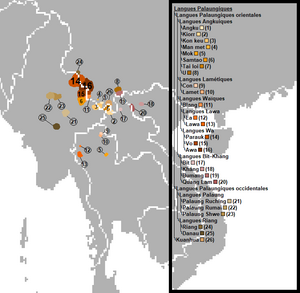The nearly thirty Palaungic or Palaung–Wa languages form a branch of the Austroasiatic languages.
| Palaungic | |
|---|---|
| Geographic distribution | Mainland Southeast Asia |
| Linguistic classification | Austroasiatic
|
| Proto-language | Proto-Palaungic |
| Glottolog | east2331 (East Palaungic) west2791 (West Palaungic) |
 Map (in French) of Palaungic languages | |
Phonological developments
Most of the Palaungic languages lost the contrastive voicing of the ancestral Austroasiatic consonants, with the distinction often shifting to the following vowel. In the Wa branch, this is generally realized as breathy voice vowel phonation; in Palaung–Riang, as a two-way register tone system. The Angkuic languages have contour tone — the U language, for example, has four tones, high, low, rising, falling, — but these developed from vowel length and the nature of final consonants, not from the voicing of initial consonants.
Homeland
Paul Sidwell (2015)[1] suggests that the Palaungic Urheimat (homeland) was in what is now the border region of Laos and Sipsongpanna in Yunnan, China. The Khmuic homeland was adjacent to the Palaungic homeland, resulting in many lexical borrowings among the two branches due to intense contact. Sidwell (2014) suggests that the word for 'water' (Proto-Palaungic *ʔoːm), which Gérard Diffloth had used as one of the defining lexical innovations for his Northern Mon-Khmer branch, was likely borrowed from Palaungic into Khmuic.
Classification
Diffloth & Zide (1992)
The Palaungic family includes at least three branches, with the position of some languages as yet unclear. Lamet, for example, is sometimes classified as a separate branch. The following classification follows that of Diffloth & Zide (1992), as quoted in Sidwell (2009:131).
- Western Palaungic (Palaung–Riang)
- Eastern Palaungic
Some researchers include the Mangic languages as well, instead of grouping them with the Pakanic languages.
Sidwell (2010)
The following classification follows the branching given by Sidwell (2010, ms).[3]
Sidwell (2014)[7] proposes an additional branch, consisting of:
Sidwell (2015)
Sidwell (2015:12) provides a revised classification of Palaungic. Bit–Khang is clearly Palaungic, but contains many Khmuic loanwords. Sidwell (2015:12) believes it likely groups within East Palaungic. On the other hand, Sidwell (2015) considers Danaw to be the most divergent Palaungic language.
- Danaw
- West Palaungic
- East Palaungic
Lexical innovations
Diagnostic Palaungic lexical innovations as identified by Paul Sidwell (2021) are:[8]
| Gloss | Proto-Palaungic | Proto-Austroasiatic |
|---|---|---|
| ‘eye’ | *ˀŋaːj | *mat |
| ‘fire’ | *ŋal | *ʔɔːs~*ʔuːs |
| ‘laugh’ | *kəɲaːs |
Reconstruction
References
- Sidwell, Paul (2010). Proto Palaungic Phonology: Reconstructing Vowel Lengths and Qualities in a Partially Restructured System (PDF). SEALS 20 (Abstract).
Further reading
- Gordon, Darren C. (2013). "A Selective Palaungic Linguistic Bibliography" (PDF). Mon-Khmer Studies. 42: xiv–xxxiii. Archived from the original (PDF) on 2015-02-09.
- Cheeseman, Nathaniel; Hall, Elizabeth; Gordon, Darren (2015). "Palaungic Linguistic Bibliography with Selected Annotations". Mon-Khmer Studies. 44: i–liv.
- Sidwell, Paul (2015). The Palaungic Languages: Classification, Reconstruction and Comparative Lexicon. München: Lincom Europa.